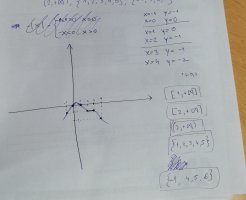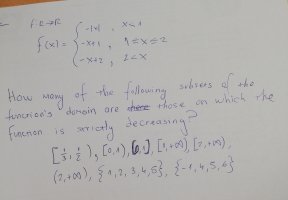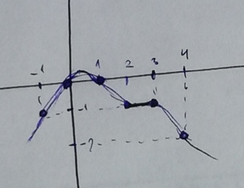Strictly decreasing
- Thread starter Loki123
- Start date
D
Deleted member 4993
Guest
Post an IMAGE of the assignmentI assume that I should use derivative here. But using derivating for every subset would take a lot of time and the last two subsets include just numbers, not an interval. What do I do?
View attachment 32477ing
topsquark
Senior Member
- Joined
- Aug 27, 2012
- Messages
- 2,370
So.... What's the derivative of f(x)?I assume that I should use derivative here. But using derivating for every subset would take a lot of time and the last two subsets include just numbers, not an interval. What do I do?
View attachment 32477ing
-Dan
I did?Post an IMAGE of the assignment
I am going to assume (because I am an optimist) that you have given a complete and exact transcription of the problem Thank you.I assume that I should use derivative here. But using derivating for every subset would take a lot of time and the last two subsets include just numbers, not an interval. What do I do?
View attachment 32477ing
Yes, derivatives are helpful, but they are trivial to calculate.
What I would do is to calculate the intervals where f(x) is strictly decreasing.
If any of your subsets is a subset of an interval that is strictly decreasing, what can you conclude?
I am not sure, since there are different forms of the function depending on the values.So.... What's the derivative of f(x)?
-Dan
How do I calculate those intervals?I am going to assume (because I am an optimist) that you have given a complete and exact transcription of the problem Thank you.
Yes, derivatives are helpful, but they are trivial to calculate.
What I would do is to calculate the intervals where f(x) is strictly decreasing.
If any of your subsets is a subset of an interval that is strictly decreasing, what can you conclude?
Also for the last question, I am not sure.
topsquark
Senior Member
- Joined
- Aug 27, 2012
- Messages
- 2,370
The derivative of a piecewise function is the derivative of all the pieces on the same intervals.I am not sure, since there are different forms of the function depending on the values.
-Dan
Dr.Peterson
Elite Member
- Joined
- Nov 12, 2017
- Messages
- 16,822
I would sketch a graph of the function, and then look at each of the given intervals or sets on that graph.I assume that I should use derivative here. But using derivating for every subset would take a lot of time and the last two subsets include just numbers, not an interval. What do I do?
In particular, for the last two sets, just note where the corresponding dots will be. The derivative is irrelevant in these cases. Without the graph, you would just evaluate the function individually at each value in the set.
D
Deleted member 4993
Guest
No - you did NOT!I did?
You posted an image of the "transcription" of your assignment. You make mistakes (spelling or otherwise) - and we have to WASTE TIME - while trying to figure out the actual wording/conditions.
i wrote it like i got it. sorry if there are any spelling mistakes, i did not see them.No - you did NOT!
You posted an image of the "transcription" of your assignment. You make mistakes (spelling or otherwise) - and we have to WASTE TIME - while trying to figure out the actual wording/conditions.
Dr.Peterson
Elite Member
- Joined
- Nov 12, 2017
- Messages
- 16,822
This particular problem has no spelling errors, and I see no reason to believe that what you showed is incorrect.i wrote it like i got it. sorry if there are any spelling mistakes, i did not see them.
But you have a history of not showing problems accurately, and, I think, not showing the original as given to you, when you have been directly asked to do so. So it has become natural not to trust what you do provide.
There are other current or recent threads where the actual problem is still doubtful, or in very poor English. (I see in another thread that you have just explained that there is no original for you to show, because it is just copied from a blackboard. It would have been very helpful if you explained that from the start, as it would explain some of the errors we see.)
But in this thread, let's get back to solving the problem. Have you tried any of the ideas that have been suggested? Are you ready to show any work?
Here it is. My biggest problem, if what I did is correct, is interval (2,3) because it does not grow or decrease. So should I include 2nd,3rd and 4th function I listed as where the function is strictly decreasing?This particular problem has no spelling errors, and I see no reason to believe that what you showed is incorrect.
But you have a history of not showing problems accurately, and, I think, not showing the original as given to you, when you have been directly asked to do so. So it has become natural not to trust what you do provide.
There are other current or recent threads where the actual problem is still doubtful, or in very poor English. (I see in another thread that you have just explained that there is no original for you to show, because it is just copied from a blackboard. It would have been very helpful if you explained that from the start, as it would explain some of the errors we see.)
But in this thread, let's get back to solving the problem. Have you tried any of the ideas that have been suggested? Are you ready to show any work?

Dr.Peterson
Elite Member
- Joined
- Nov 12, 2017
- Messages
- 16,822
Your graph is incorrect:
Please try again, not just plotting separate points at integer values of x and connecting them as you please, but carefully graphing each piece.
For example, the first piece is −∣x∣ for x<−1. Where should the sharp bend be located? And where should there be an open dot for x=−1?
Please try again, not just plotting separate points at integer values of x and connecting them as you please, but carefully graphing each piece.
For example, the first piece is −∣x∣ for x<−1. Where should the sharp bend be located? And where should there be an open dot for x=−1?
i might be familiar with terms sharp bend and open dot, but not recognize them in english. could you give me some more information?Your graph is incorrect:
Please try again, not just plotting separate points at integer values of x and connecting them as you please, but carefully graphing each piece.
For example, the first piece is −∣x∣ for x<−1. Where should the sharp bend be located? And where should there be an open dot for x=−1?
Dr.Peterson
Elite Member
- Joined
- Nov 12, 2017
- Messages
- 16,822
Just make the graph, and I can point it out!i might be familiar with terms sharp bend and open dot, but not recognize them in english. could you give me some more information?
I was avoiding technical terms, expecting you to have drawn graphs like this and recognize from that experience what I was talking about.
The graph of y=|x| has a "sharp bend" at the origin; that is, it suddenly changes direction. Do you see that? Part of the graph you make will have the same feature.
We put a dot at places on a piecewise graph where the domain ends or the graph "jumps".
Here is a page that includes examples of open (empty) and closed (solid) dots:
It also shows an absolute value function. Here are more examples:

Graphing the absolute value of a straight line
When you graph the absolute value of a straight line, you should expect to end up with some sort of "V" shape; the graph should have a sharp turn.
Have you seen these things before?
Steven G
Elite Member
- Joined
- Dec 30, 2014
- Messages
- 14,591
These functions are all lines!!! A line is decreasing if the slope of the line, which you can read off, is negative
f(x) = -|x|. This means that f(x) = x, if x<0 and f(x) = - x if x>0. Now f(x) = x has a slope of 1 when f(x) = -1 has a slope of -1
Now since f(x) = -|x| if x<1, the slope is negative (-1) when 0<= x <1.
f(x) = -|x|. This means that f(x) = x, if x<0 and f(x) = - x if x>0. Now f(x) = x has a slope of 1 when f(x) = -1 has a slope of -1
Now since f(x) = -|x| if x<1, the slope is negative (-1) when 0<= x <1.
i don't know how to do it with absolute.Have you tried to take that derivative yet?
-Dan
what about the interval (2,3)These functions are all lines!!! A line is decreasing if the slope of the line, which you can read off, is negative
f(x) = -|x|. This means that f(x) = x, if x<0 and f(x) = - x if x>0. Now f(x) = x has a slope of 1 when f(x) = -1 has a slope of -1
Now since f(x) = -|x| if x<1, the slope is negative (-1) when 0<= x <1.
This problem is a bit tricky because the intervals specified in defining the function are not sufficient to determine the question of the intervals that are strictly decreasing. We need the definition of strictly decreasing, namelyf(x) is strictly decreasing on (a, b)⟺a<x<b⟹f(a)>f(x)>f(b).These functions are all lines!!! A line is decreasing if the slope of the line, which you can read off, is negative
f(x) = -|x|. This means that f(x) = x, if x<0 and f(x) = - x if x>0. Now f(x) = x has a slope of 1 when f(x) = -1 has a slope of -1
Now since f(x) = -|x| if x<1, the slope is negative (-1) when 0<= x <1.
Given a<b and a≤x≤b⟹f(x)∈R,f(x) is strictly decreasing over (a, b)⟺f(a)>f(x)>f(b).
This definition must be adjusted in obvious ways for partially or fully closed intervals.
Now the absolute value function is not everywhere differentiable. The derivative does not exist at 0. So let’s consider the interval (−∞, 0).
f(x)=−∣x∣.But −∞<x<0⟹∣x∣=−x⟹f(x)=−(−x)=x⟹f’(x)=1, f(x)<0,and f(x) is strictly increasing over (−∞, 0].
Now do the same for (0, 1). What is f(1)? Your conclusions?
How about (1, 2)? What is f(2)? How about if x > 2?
What does your analysis say about that neighborhood?what about the interval (2,3)


